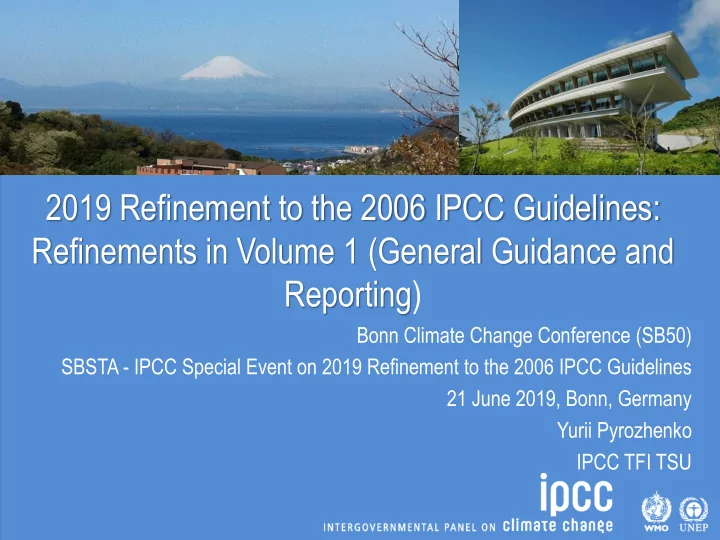

2019 Refinement to the 2006 IPCC Guidelines: Refinements in Volume 1 (General Guidance and Reporting) Bonn Climate Change Conference (SB50) SBSTA - IPCC Special Event on 2019 Refinement to the 2006 IPCC Guidelines 21 June 2019, Bonn, Germany Yurii Pyrozhenko IPCC TFI TSU
Outline
GGR objectives To guide inventory compilers of Energy, IPPU, AFOLU and Waste sectors on: National GHG Inventory arrangements and management tools Data collection and adapting for inventory use Uncertainty assessment Methodological choice and identification of key categories Ensuring a consistent time series QA/QC and verification of emission estimates Use and reporting of models Calculation of emissions of precursors of GHGs and indirect emissions Reporting of emissions and removals To provide reporting framework in standard tabular format: Tables facilitate consistency between countries, categories, gases and years They are not intended to prescribe specific reporting formats under the UNFCCC
Chapter 1 “Introduction to National GHG Inventories” New guidance on implementation of a national inventory management system, including: Establishing arrangements to support the development, improvement and maintenance of national GHG inventories Examples of institutional arrangements structuring, roles and capabilities of actors and stakeholders, data flows and suggested contents of Data Supply Agreements Description of inventory management tools such as work plans, improvement plans, data management systems and quality systems with the illustrative examples Updated concept of “anthropogenic emissions and removals related to new optional approach for disaggregation of emissions and removals by human and natural components in Chapter 2 of Volume 4 Elaborated guidance on the treatment of CO ₂ , CH ₄ and N ₂ O emissions from combustion of biomass or biomass-based products
Chapter 2 “Approaches to data collection” New guidance for the development of CS emission factors, including: Examples of main EF sensitive parameters Potential sources of EFs Update on standard measurement methods New guidance for data collection, including: Outline of data collection steps and decisions Treatment of confidential data with illustrative examples Update on potential data sources New guidance on the integration of emissions reported from facilities into national GHG inventories, including: Designing facility-reporting programmes for inventory use (e.g. quality goals and reporting requirements for facility data) Facility-reported data integration options into national dataset with illustrative example Use of facility data not originally designed for inventory use
Chapter 3 “Uncertainties” Updated guidance on uncertainty by providing more default values, calculation examples and best practices, including: Structure of uncertainty assessment process AD uncertainty assessment based on complete and random samples (with examples) Clarification on key requirements for use of Approach 1 for combining uncertainties Application of Approach 1 in practice Uncertainty assessment steps description Stepwise example demonstrating the use of Approach 2 uncertainty assessment (Monte-Carlo analysis) Excel-based addendum to Chapter 3: Tier 1 Uncertainty calculation tool
Chapter 4 “Methodological Choice and Identification of Key Categories” and Chapter 5 “Time series consistency” Updated guidance on Key category analysis, including: Treatment of disaggregation of categories Treatment of particularly significant subcategories Simplification of equation on trend assessment (Approach 1) Introducing of key categories ranks Elaborated guidance on time series consistency, including: Information on how to ensure time series consistency when using facility level data and different data sources Case studies of overlap, linear and non-linear interpolation method Examples of surrogate data by sector
Chapter 6 “ QA/QC and Verification” Elaborated definitions of QA/QC and verification, including: Distinguishing of term “verification” defined in IPCC Guidelines from that used e.g. in carbon markets Updated guidance on comparisons with atmospheric measurements, including: Advantages, limitations and prospects of using atmospheric measurements for verification of GHG emissions Key steps in applying inverse modelling for verification of national inventory (with country examples) Checklist to identify whether inverse model estimates are applicable for verification Outline of inventory comparison to global/regional inverse modelling products and satellite observations New guidance on the use and reporting of models, including: Identification of model suitability Implementation and evaluation of model Checklist for ensuring good practice in use of models
Chapter 7 “Precursors and indirect emissions” Elaborated guidance on indirect CO ₂ inputs to the atmosphere from emissions of carbon-containing compounds, including: Treatment of emissions of precursors and indirect CO ₂ from fossil fuel combustion, fugitives and biogenic sources in national inventories Options to address indirect CO ₂ depending on metrics chosen (e.g. GWP for fossil methane) Steps to estimate CO ₂ inputs to atmosphere from NMVOC emissions Description of non-biogenic sources of indirect CO ₂ from oxidation of CH ₄ , CO and NMVOC Carbon content in NMVOC species from different source categories Carbon content in solvent portion of various materials (NMVOC emissions)
Chapter 8 “Reporting Guidance and Tables” Updated to reflect refinements made in other Volumes (although it was not explicitly included in the original scope of refinements), including: Reporting guidance List of GHGs List of IPCC categories and their definitions Reporting Tables Chapter is not intended to prescribe reporting format to be used under the UNFCCC (e.g. GWP, gases, structure of categories etc.)
Thank you Link to the TFI web-site: https://www.ipcc-nggip.iges.or.jp/ Link to the accepted 2019 Refinement (advance version): https://www.ipcc-nggip.iges.or.jp/public/2019rf/index.html
Recommend
More recommend